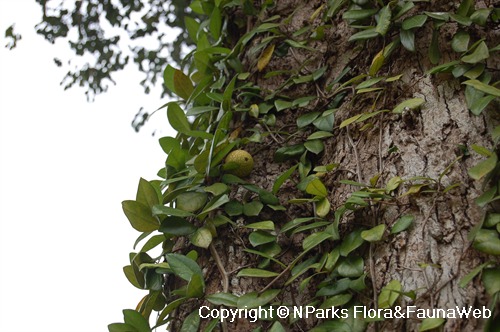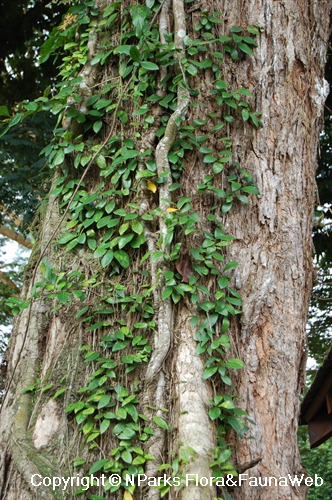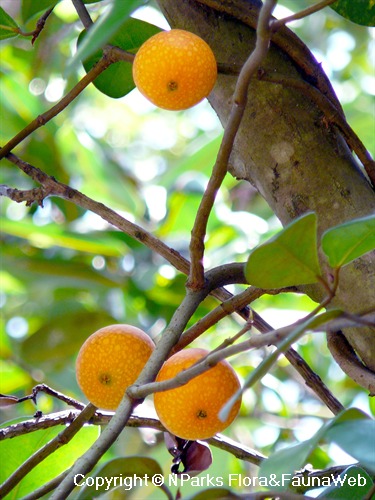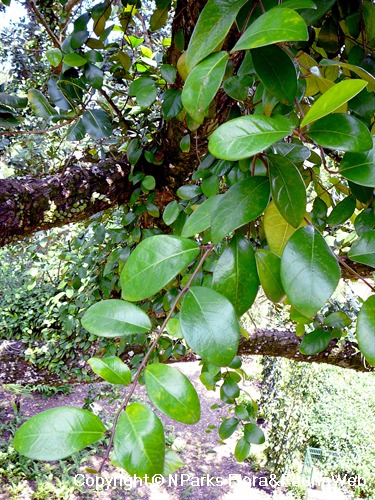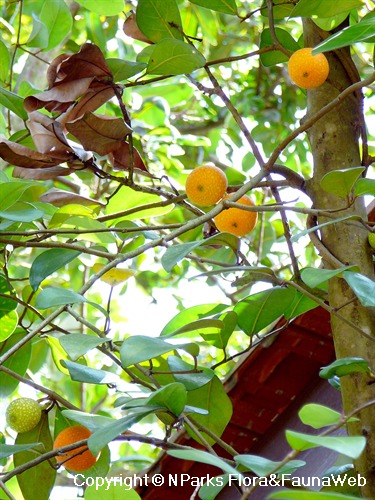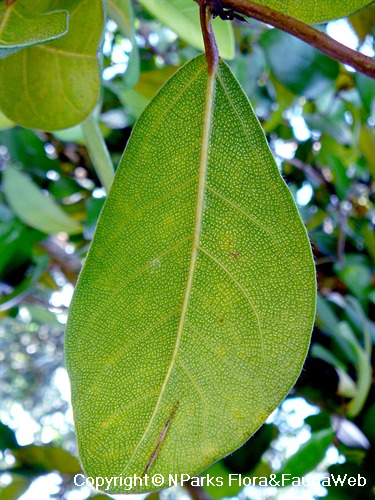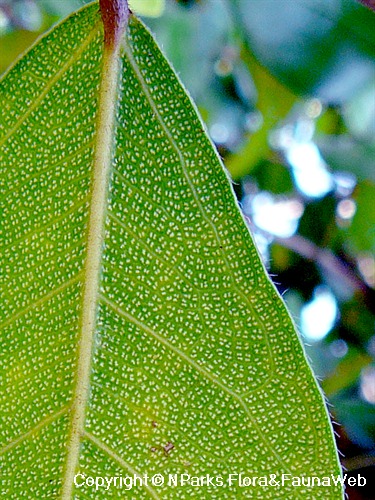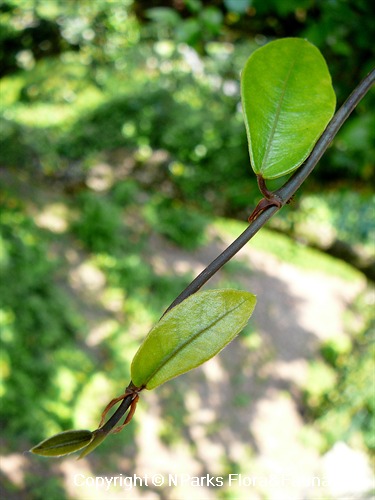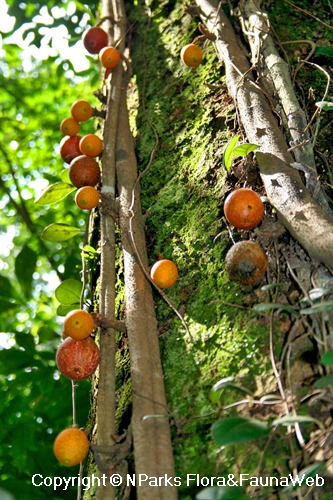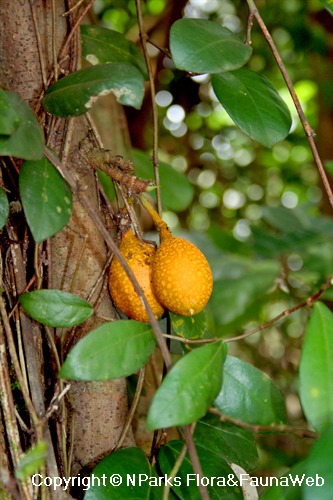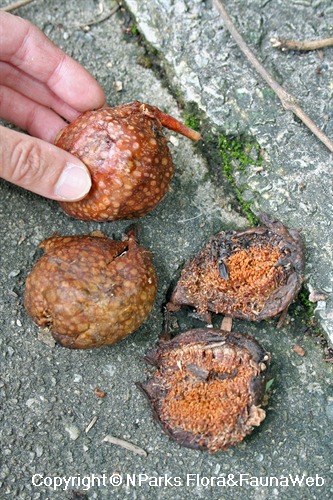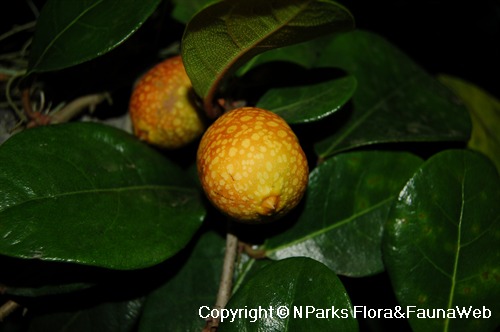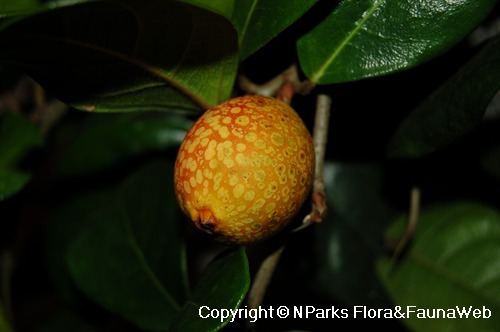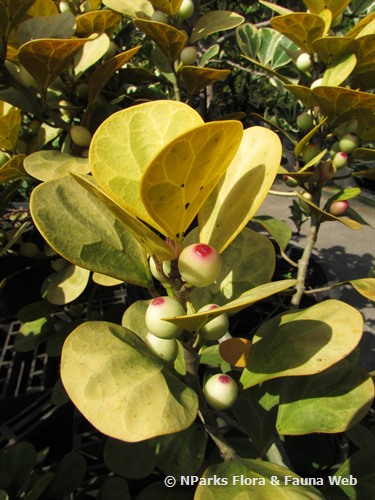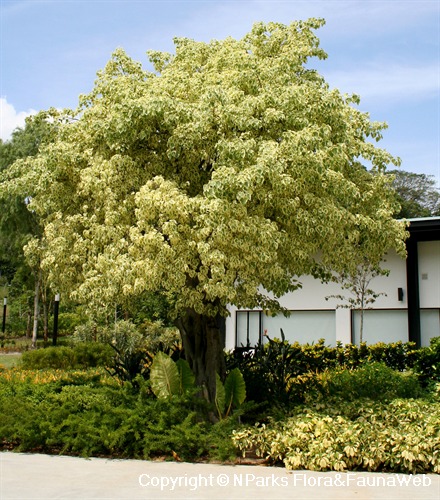
Back
Ficus punctata Thunb.
| Family Name: | Moraceae |
| Synonyms: | Ficus aurantiacea Griff. |
| Common Name: | Climbing Fig, Tangisong Burong, 橙黄榕, 大果藤榕 |
Name
Classifications and Characteristics
| Plant Division | Angiosperms (Flowering Seed Plants) (Dicotyledon) |
|---|---|
| Plant Growth Form | Climber |
| Lifespan (in Singapore) | Perennial |
| Mode of Nutrition | Autotrophic |
| Plant Shape | Irregular |
Biogeography
| Native Distribution | Taiwan, Indochina, Philippines, Malaysia, Singapore, Indonesia |
|---|---|
| Native Habitat | Terrestrial |
| Preferred Climate Zone | Tropical, Sub-Tropical / Monsoonal |
| Local Conservation Status | Native to Singapore (Least Concern (LC)) |
Description and Ethnobotany
| Growth Form | Woody root climber, rooting freely from stems and branches to attach itself to trunk and branches of host tree. Established specimens can form relatively thick liana-like stems against host trunk, as well as trailing leafy branches. Sometimes observed to creep on ground. All bruised parts exude milky-white latex. |
|---|---|
| Foliage | Its alternate, stalked leaves have leathery leaf blades that are oblong to elliptic to obovate to broadly sickle shaped, 1-12 cm long by 0.5-7.5 cm wide, glossy dark green above, light green below with prominent netted venation. Leaf margins and undersides sparsely hairy. Leaf stalks hairy. |
| Flowers | The plant is dioecious, with different plants producing male or female flowers. |
| Fruit | Its syconia (figs) are globose to ovoid, fleshy, very large (up to 10 cm across), sessile and produced at leaf axils or along leafless branches. They ripen from green to speckled orange (resembling kumquats), turning purple-black and possessing fruity scent when overripe. Fruiting takes place several times per year, but only climbing specimens can bear fruits. Large numbers of fruits may be produced during each figging episode, such that fallen ones are often spotted lying on the ground beneath the host tree. |
| Reproductive Parts - non-flowering plant | Its syconia (figs) are solitary or in pairs, borne in the leaf axils, pear-shaped, 4–6.5 by 1.5–2.5 cm, and orange to red, then purple to black when ripe. |
| Habitat | Occurs on larger trees in lowland secondary forests and along roadsides. |
| Associated Fauna | Its flowers are pollinated by fig wasps. The ripe figs are eaten by frugivorous mammals. It is the host plant of the Little Maplet (Chersonesia peraka peraka). |
| Etymology | Latin Ficus, the commercial edible fig (Ficus carica); Latin punctata, punctate, with a spotted surface, referring to the speckled ripe fruits. |
Landscaping Features
| Landscaping | It is suitable for growing on trees in parks, gardens and roadsides. |
|---|---|
| Desirable Plant Features | Ornamental Fruits |
| Landscape Uses | General, Vertical Greenery / Green Wall, Parks & Gardens, Small Gardens, Groundcover |
| Thematic Landscaping | Naturalistic Garden |
Fauna, Pollination and Dispersal
| Pollination Method(s) | Biotic (Fauna) (Insects (Ant, Beetle, Fly, Thrip, Wasp)) |
|---|---|
| Seed or Spore Dispersal | Biotic (Fauna) |
Plant Care and Propagation
| Light Preference | Semi-Shade, Full Sun |
|---|---|
| Water Preference | Moderate Water |
| Plant Growth Rate | Fast |
Foliar
| Foliage Retention | Evergreen |
|---|---|
| Mature Foliage Colour(s) | Green |
| Mature Foliage Texture(s) | Smooth, Glossy / Shiny, Leathery |
| Foliar Modification | Stipule |
| Foliar Type | Simple / Unifoliate |
| Foliar Arrangement Along Stem | Alternate |
| Foliar Shape(s) | Non-Palm Foliage (Obovate, Elliptical) |
| Foliar Venation | Pinnate / Net |
| Foliar Margin | Entire |
| Foliar Apex - Tip | Acute, Rounded |
| Foliar Base | Rounded / Obtuse, Cuneate |
| Typical Foliar Area | Microphyll ( 2.25cm2 - 20.25 cm2 ) |
Non - Foliar and Storage
| Stem Type & Modification | Woody |
|---|---|
| Root Type | Underground (Fibrous Root) |
Floral (Angiosperm)
| Flower & Plant Sexuality | Unisexual Flowers , Dioecious |
| Flower Colour(s) | Cream / Off-White |
|---|
| Flower Grouping | Cluster / Inflorescence |
| Flower Location | Cauliflorous |
| Inflorescence Type | Syconium |
| Flowering Period | Free-Flowering |
| Flowering Habit | Polycarpic |
Fruit, Seed and Spore
| Mature Fruit Colour(s) | Orange, Black, Yellow / Golden |
|---|---|
| Fruit Classification | Simple Fruit |
| Fruit Type | Fleshy Fruit , Multiple Syconium (receptacle) |
Image Repository
Others
| Master ID | 108 |
|---|---|
| Species ID | 1404 |
| Flora Disclaimer | The information in this website has been compiled from reliable sources, such as reference works on medicinal plants. It is not a substitute for medical advice or treatment and NParks does not purport to provide any medical advice. Readers should always consult his/her physician before using or consuming a plant for medicinal purposes. |

